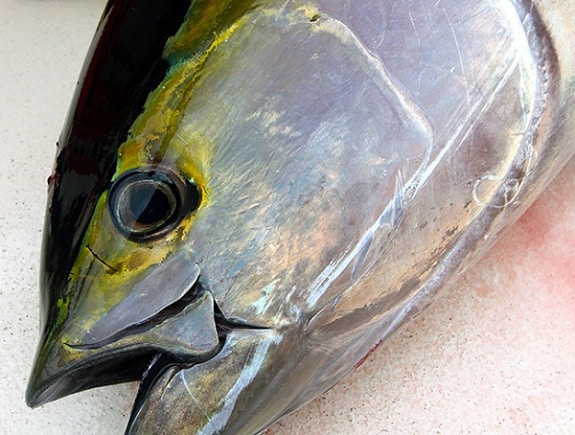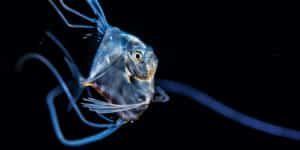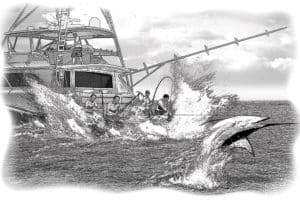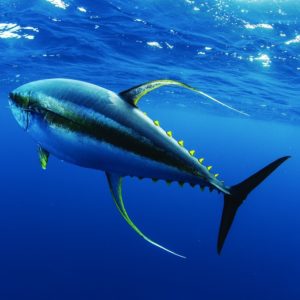
mp long range
Usually when California anglers talk about “scratch fishing” it means the fishing is slow, and therefore anglers have to pick and scratch away to get fish to the boat. Things change when you purposely scratch fish because your targets are yellowfin tuna that top 200 pounds.
We fished a ridge along the Lower Banks today, about 50 miles from Cabo San Lucas. Just 25 miles from shore most of the time, we were able to see the outlines of mountains like sketch drawings along the horizon. There was never a morning or evening bite, but many hours of soak time where we urged our mackerel baits away from the boat. The theory was, the farther the baits were from the boat, the more likely to get bit. Casting a mackerel was tough with the 100-pound tackle we used.
There was lots of maneuvering along the rails as we followed our mackerel whichever way they swam. The only way to prevent tangles with other lines is to keep the line tight, and to keep following your bait along the rail.
About 5 anglers hooked the fish of a lifetime today.
What can truly be considered “trophy hunting,” the yellowfin tuna all weighed from 170 to 270 pounds. Anything over 200 pounds is considered a cow. Tonight, at dinner, I sat with three anglers that were celebrating their catches. They were some of the lucky ones — Tom Walker landed a 262-pounder, Phile Wade a 195-pounder, and John Finneran a 172-pounder. All fish were caught on 100-plus-pound tackle using stand-up techniques. That means there was no fighting chair and the boat was anchored. They deserved the praise they received over delicious pork and beets dinner. In fact, all the food on this trip is unbelievable, and it’s something all the anglers look forward to before breakfast, lunch and dinner.
While scratching around throughout the day, 4 or 5 striped marlin were hooked but only one made it to the boat. They are mostly considered a nuisance. Even though tourists out of Cabo target the marlin, they only get in the way on long-range boats. They’re not kept and they mess up the expensive and time-consuming leaders used for tuna. Other incidental catches included blue sharks, plus a couple of sea bass that resembled the snowy grouper I’m familiar with on the East Coast.
Today was also the first time I got to see the kite rig deployed for tuna. Similar to the kites used for sailfish off Miami, this rig employed a balloon and kite from a kite rod. The actual fishing rod used to catch tuna was attached to the rig via an outrigger clip. What was different was the long range boat Royal Star employs a double trouble rig below the kite. That’s a pair of sardines hanging off different leaders attached to a single swivel. The swivel attaches to the main line of the fishing outfit. It gives the angler two chances to hook a tuna without having to re-bait, and surprisingly it doesn’t often tangle.
Tonight, we’re anchoring on the same bank that we fished this morning. We’re hoping an early morning bite could lead to some more trophy tunas. If there’s no action by morning’s end, Capt. Ekstrom said he’ll have us head north to the ridges and other banks that follow the Baja Peninsula. Tomorrow morning, at about 4:30 a.m., we’re hoping the bite is wide open!







